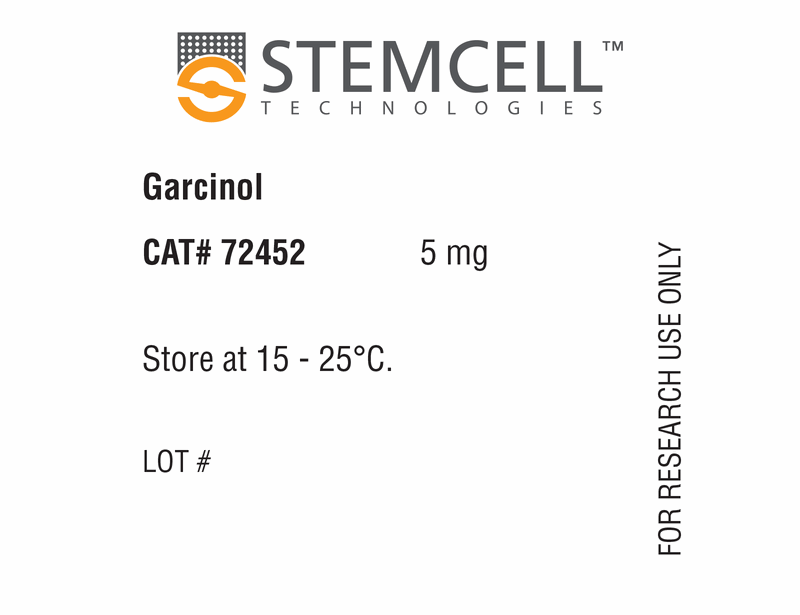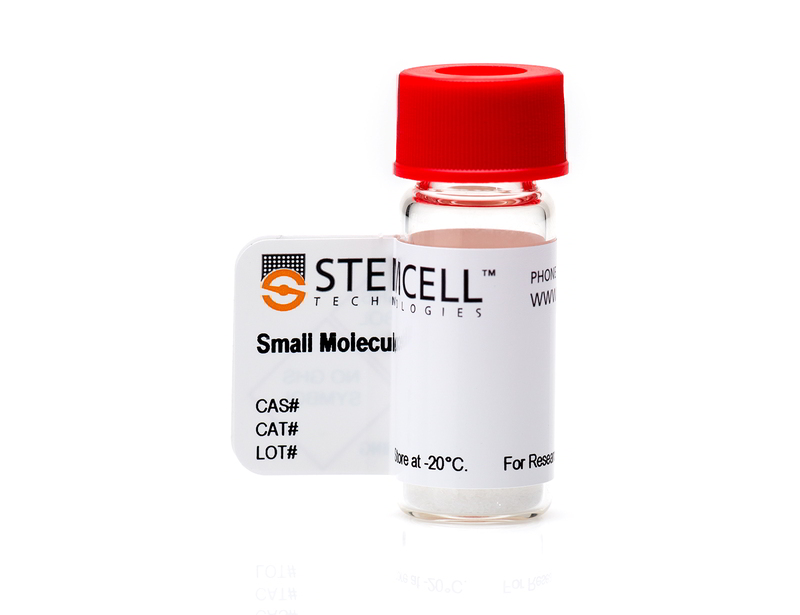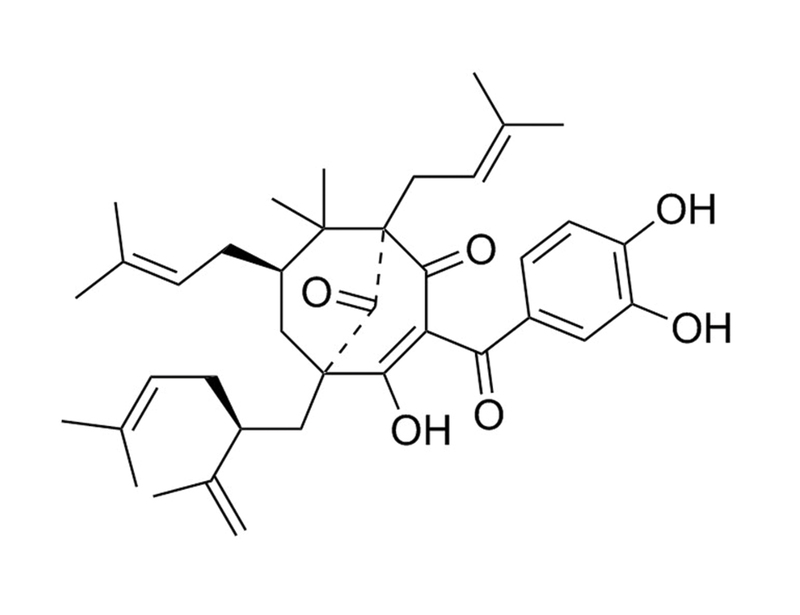Garcinol
Epigenetic modifier; Inhibits histone acetyltransferases (HATs) p300 and pCAF
概要
Garcinol is an inhibitor of histone acetyltransferases (HATs) p300 and pCAF (IC₅₀ = 7 and 5 μM, respectively) (Balasubramanyam et al.). It also inhibits the HAT GCN5 in Cryptococcus neoformans, inducing temperature sensitivity and impairing growth (O’Meara et al.).
MAINTENANCE AND SELF-RENEWAL
· Promotes ex vivo expansion of human hematopoietic stem cells (Nishino et al.).
DIFFERENTIATION
· Promotes neurogenesis in rat cortical progenitor cells (Weng et al.).
CANCER
· Induces apoptosis in several types of cancer cells and has anti-inflammatory actions (Koeberle et al.; Prasad et al.).
MAINTENANCE AND SELF-RENEWAL
· Promotes ex vivo expansion of human hematopoietic stem cells (Nishino et al.).
DIFFERENTIATION
· Promotes neurogenesis in rat cortical progenitor cells (Weng et al.).
CANCER
· Induces apoptosis in several types of cancer cells and has anti-inflammatory actions (Koeberle et al.; Prasad et al.).
Alternative Names
Camboginol
Cell Type
Cancer Cells and Cell Lines, Hematopoietic Stem and Progenitor Cells, Neural Stem and Progenitor Cells, Neurons
Species
Human, Mouse, Rat, Non-Human Primate, Other
Application
Differentiation, Expansion
Area of Interest
Cancer Research, Neuroscience, Stem Cell Biology
CAS Number
78824-30-3
Chemical Formula
C₃₈H₅₀O₆
Molecular Weight
602.8 g/mol
Purity
≥ 95%
Pathway
Epigenetic
Target
HAT
技术资料
| Document Type | 产品名称 | Catalog # | Lot # | 语言 |
|---|---|---|---|---|
| Product Information Sheet | Garcinol | 72452 | All | English |
| Safety Data Sheet | Garcinol | 72452 | All | English |
数据及文献
Publications (6)
Journal of agricultural and food chemistry 2011 MAR
Garcinol promotes neurogenesis in rat cortical progenitor cells through the duration of extracellular signal-regulated kinase signaling.
Abstract
Abstract
Garcinol is a polyisoprenylated benzophenone derivative found in Garcinia indica fruit rind and other species. The potential antioxidative and neuroprotective effects of garcinol in rat cortical astrocyte were demonstrated in our laboratory recently. Here, the effects of garcinol on the neuritogenesis process in cultured cortical progenitor cells were investigated to understand the roles of garcinol in neuronal survival and differentiation. These cells, derived from embryonic day 17 rats, differentiated into EGF-responsive neural precursor cells, would further form neurospheres. Our data exhibited garcinol induced neurite outgrowth in early developing EGF-treated neurospheres and significantly enhanced the expression of neuronal proteins, microtubule-associated protein 2 (MAP-2), and glial fibrillary acidic protein (GFAP). Furthermore, the neuronal marker, high-molecular-weight subunit of neurofilaments (NFH), was highly expressed after 5 μM garcinol treatment in neural precursor cells for 20 days. To identify the extracellular mechanism, rat cortical progenitor cells were treated garcinol and accordingly mediated the sustained activation of extracellular signal-regulated kinase (ERK) for different periods up to 20 h. In this regard, NMDA receptor-mediated calcium influx led to excitotoxic death and activated tyrosine phosphatase which limited the duration of ERK in cultured neurons. MK801, the NMDA receptor antagonist, treatment also induced the sustained phosphorylation of ERK and therefore enhanced neuronal survival. In our observation, garcinol treatment reduced growth factor deprivation-mediated cell death and nuclear import of C/EBPβ levels. Noteworthy, garcinol could promote neurite outgrowth in EGF-responsive neural precursor cells and modulate the ERK pathway in the enhancement of neuronal survival.
PloS one 2011 JAN
Ex vivo expansion of human hematopoietic stem cells by garcinol, a potent inhibitor of histone acetyltransferase.
Abstract
Abstract
BACKGROUND: Human cord blood (hCB) is the main source of hematopoietic stem and progenitor cells (HSCs/PCs) for transplantation. Efforts to overcome relative shortages of HSCs/PCs have led to technologies to expand HSCs/PCs ex vivo. However, methods suitable for clinical practice have yet to be fully established. METHODOLOGY/PRINCIPAL FINDINGS: In this study, we screened biologically active natural products for activity to promote expansion of hCB HSCs/PCs ex vivo, and identified Garcinol, a plant-derived histone acetyltransferase (HAT) inhibitor, as a novel stimulator of hCB HSC/PC expansion. During a 7-day culture of CD34(+)CD38(-) HSCs supplemented with stem cell factor and thrombopoietin, Garcinol increased numbers of CD34(+)CD38(-) HSCs/PCs more than 4.5-fold and Isogarcinol, a derivative of Garcinol, 7.4-fold. Furthermore, during a 7-day culture of CD34(+) HSCs/PCs, Garcinol expanded the number of SCID-repopulating cells (SRCs) 2.5-fold. We also demonstrated that the capacity of Garcinol and its derivatives to expand HSCs/PCs was closely correlated with their inhibitory effect on HAT. The Garcinol derivatives which expanded HSCs/PCs inhibited the HAT activity and acetylation of histones, while inactive derivatives did not. CONCLUSIONS/SIGNIFICANCE: Our findings identify Garcinol as the first natural product acting on HSCs/PCs and suggest the inhibition of HAT to be an alternative approach for manipulating HSCs/PCs.
Eukaryotic cell 2010 AUG
Cryptococcus neoformans histone acetyltransferase Gcn5 regulates fungal adaptation to the host.
Abstract
Abstract
Cryptococcus neoformans is an environmental fungus and an opportunistic human pathogen. Previous studies have demonstrated major alterations in its transcriptional profile as this microorganism enters the hostile environment of the human host. To assess the role of chromatin remodeling in host-induced transcriptional responses, we identified the C. neoformans Gcn5 histone acetyltransferase and demonstrated its function by complementation studies of Saccharomyces cerevisiae. The C. neoformans gcn5Delta mutant strain has defects in high-temperature growth and capsule attachment to the cell surface, in addition to increased sensitivity to FK506 and oxidative stress. Treatment of wild-type cells with the histone acetyltransferase inhibitor garcinol mimics cellular effects of the gcn5Delta mutation. Gcn5 regulates the expression of many genes that are important in responding to the specific environmental conditions encountered by C. neoformans inside the host. Accordingly, the gcn5Delta mutant is avirulent in animal models of cryptococcosis. Our study demonstrates the importance of chromatin remodeling by the conserved histone acetyltransferase Gcn5 in regulating the expression of specific genes that allow C. neoformans to respond appropriately to the human host.
Molecular cancer therapeutics 2010 APR
Garcinol potentiates TRAIL-induced apoptosis through modulation of death receptors and antiapoptotic proteins.
Abstract
Abstract
Whether garcinol, the active component of Garcinia indica, can modulate the sensitivity of cancer cells to TRAIL, a cytokine currently in phase II clinical trial, was investigated. We found that garcinol potentiated TRAIL-induced apoptosis of cancer cells as indicated by intracellular esterase activity, DNA strand breaks, accumulation of the membrane phospholipid phosphatidylserine, mitochondrial activity, and activation of caspase-8, -9, and -3. We found that garcinol, independent of the cell type, induced both of the TRAIL receptors, death receptor 4 (DR4) and DR5. Garcinol neither induced the receptors on normal cells nor sensitized them to TRAIL. Deletion of DR5 or DR4 by small interfering RNA significantly reduced the apoptosis induced by TRAIL and garcinol. In addition, garcinol downregulated various cell survival proteins including survivin, bcl-2, XIAP, and cFLIP, and induced bid cleavage, bax, and cytochrome c release. Induction of death receptors by garcinol was found to be independent of modulation of CCAAT/enhancer-binding protein-homologous protein, p53, bax, extracellular signal-regulated kinase, or c-Jun-NH(2)-kinase. The effect of garcinol was mediated through the generation of reactive oxygen species, in as much as induction of both death receptors, modulation of antiapoptotic and proapoptotic proteins, and potentiation of TRAIL-induced apoptosis were abolished by N-acetyl cysteine and glutathione. Interestingly, garcinol also converted TRAIL-resistant cells into TRAIL-sensitive cells. Overall, our results indicate that garcinol can potentiate TRAIL-induced apoptosis through upregulation of death receptors and downregulation of antiapoptotic proteins. Mol Cancer Ther; 9(4); 856-68. (c)2010 AACR.
Biochemical pharmacology 2009 MAY
Identification of 5-lipoxygenase and microsomal prostaglandin E2 synthase-1 as functional targets of the anti-inflammatory and anti-carcinogenic garcinol.
Abstract
Abstract
Garcinol (camboginol) from the fruit rind of Guttiferae species shows anti-carcinogenic and anti-inflammatory properties, but the underlying molecular mechanisms are unclear. Here we show that garcinol potently interferes with 5-lipoxygenase (EC 7.13.11.34) and microsomal prostaglandin (PG)E2 synthase (mPGES)-1 (EC 5.3.99.3), enzymes that play pivotal roles in inflammation and tumorigenesis. In cell-free assays, garcinol inhibited the activity of purified 5-lipoxygenase and blocked the mPGES-1-mediated conversion of PGH2 to PGE2 with IC50 values of 0.1 and 0.3 microM, respectively. Garcinol suppressed 5-lipoxygenase product formation also in intact human neutrophils and reduced PGE2 formation in interleukin-1beta-stimulated A549 human lung carcinoma cells as well as in human whole blood stimulated by lipopolysaccharide. Moreover, garcinol interfered with isolated cyclooxygenase (COX)-1 (EC 1.14.99.1, IC50 = 12 microM) and with the formation of COX-1-derived 12(S)-hydroxy-5-cis-8,10-trans-heptadecatrienoic acid and thromboxane B2 in human platelets. In contrast, neither Ca2+-ionophore (A23187)-induced arachidonic acid release in neutrophils nor COX-2 activity in A549 cells or whole blood, measured as formation of 6-keto PGF1alpha, or isolated human recombinant COX-2 were significantly affected by garcinol (textless or = 30 microM). Together, the high potency of garcinol to selectively suppress PGE2 synthesis and 5-lipoxygenase product formation provides a molecular basis for the anti-inflammatory and anti-carcinogenic effects of garcinol and rationalizes its therapeutic use.
The Journal of biological chemistry 2004 AUG
Polyisoprenylated benzophenone, garcinol, a natural histone acetyltransferase inhibitor, represses chromatin transcription and alters global gene expression.
Abstract
Abstract
Histone acetylation is a diagnostic feature of transcriptionally active genes. The proper recruitment and function of histone acetyltransferases (HATs) and deacetylases (HDACs) are key regulatory steps for gene expression and cell cycle. Functional defects of either of these enzymes may lead to several diseases, including cancer. HATs and HDACs thus are potential therapeutic targets. Here we report that garcinol, a polyisoprenylated benzophenone derivative from Garcinia indica fruit rind, is a potent inhibitor of histone acetyltransferases p300 (IC50 approximately 7 microm) and PCAF (IC50 approximately 5 microm) both in vitro and in vivo. The kinetic analysis shows that it is a mixed type of inhibitor with an increased affinity for PCAF compared with p300. HAT activity-dependent chromatin transcription was strongly inhibited by garcinol, whereas transcription from DNA template was not affected. Furthermore, it was found to be a potent inducer of apoptosis, and it alters (predominantly down-regulates) the global gene expression in HeLa cells.



